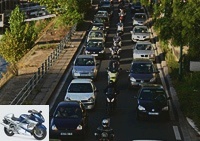Climbing up the queues is inseparable from the practice of motorcycles and scooters

There is evidence that it is sometimes good to remember: according to the new 2-Roues Lab ‘survey, the Mutuelle des Motards laboratory, inter-traffic and the rise of lines are inseparable from the practice of 2-wheelers in the middle. urban.
According to the survey carried out by 2-Roues Lab ‘among 2000 motorcyclists and scooter riders, interfile traffic is practiced by 97.5% of users, whether in town (91% use it in urban areas) and in peri-urban areas. urban (83%).
Rarer on roads and motorways, interlocking traffic is nevertheless practiced by nearly 40% of motorcyclists and scooter riders regardless of the type of network (cities, highways, ring roads).
"Save time, make traffic more fluid, limit pollution and improve safety"
"This practice saves time, streamlines traffic, limits pollution and even improves the safety of two-wheeler drivers, provided it is practiced with respect for other users, in the spirit of ” intelligent sharing of the road", recalls the survey.
|
Raising the queues and accidentology |
|
While for a certain legalization of this practice, two-wheeler drivers are mostly in favor of the legalization of interfile traffic: 52% for total legalization, 71% for legalization relating only to peripherals and ring roads and 75% for legalization in town.
In addition to the type of network concerned (legalization could for example only concern motorway-type lanes), it will also remain to set the maximum speed differential to be observed between the two-wheeler and other vehicles..
20 km / h differential
According to the 2-Roues Lab ‘survey, 50% of motorcyclists and scooter riders reasonably estimate it at 20 km / h, joining the recommendations of the French Federation of Angry Bikers (FFMC) and the Association for the training of motorcyclists (AFDM).
Not surprisingly, two-wheeler drivers have "mostly aware of the risk of the accident, which allows them to adopt a responsible attitude", recalls 2-Roues Lab ‘:"56% waited until they had acquired experience to use the interface".
A behavioral study by the French Institute of Transport, Planning and Network Sciences and Technologies (IFSTTAR) indeed shows that the risk is greater among novices because "fear can lead to inappropriate behavior in them, hence the need to enrich initial training", considers 2-Roues Lab ‘, indicating that"to signal themselves during this practice, 8 out of 10 users use the indicators and warnings. However, 48% of those surveyed still said they were uncomfortable when they walked through the interlock".
|
Methodology |
| Survey conducted by email from July 16 to 30, 2012 among 1,941 members of 2-Roues Lab ‘. 2-Roues Lab ‘invites all bikers and scooter riders to join it for and advance two-wheel research. |
In addition, "only 55% of respondents believe they are well trained in the practice of interfile circulation", wheras’"a certain number of answers testify to the lack of benchmarks of the drivers of two-wheelers to "choose" a path where to practice the interfile, an observation which directly refers to the problem of training in two-wheel driving".
On the other hand, if bikers and scooter riders consider that "motorists are mostly benevolent towards two-wheelers, especially in interlocking traffic situations", only 5% believe motorists"sufficiently trained to understand the movement of two-wheelers between the lines".
Related articles
-
Road safety – Safety: the 7 proposals of the Mutuelle des Motards –
Safety: the 7 proposals of the Mutuelle des Motards As part of the Parliamentary Information Mission relating to the analysis of the causes of traffic…
-
Road safety – Motorcycle and scooter equipment: insurers are investigating –
Motorcycle and scooter equipment: insurers are investigating The Assureurs Prevention association and the GEMA Prevention group conducted a survey among…
-
Road safety – The rise of motorcycle queues would be limited to expressways –
Raising the queues by motorbike would be limited to expressways The report of the prefect Regis Guyot on the circulation of motorcycles and scooters…
-
Road safety – FFMC: traffic between queues must be taught –
FFMC: traffic between queues must be taught A few days before its big comeback in the street for the recognition of the specificities of motorized two-…
-
Road safety – Bikers have three times fewer accidents than motorists –
Bikers have three times fewer accidents than motorists According to a study published yesterday by AXA France, bikers have three times fewer accidents…
-
Road safety – The media offensive –
The media offensive One month after the Belgian initiative, French road safety is launching its communication campaign for the general public in favor of…
-
Road safety – The FFMC is concerned about the government’s double talk –
The FFMC is concerned about the government’s double talk While tomorrow it will submit its proposals to improve road safety for motorized two-wheelers,…
-
A new survey paints a portrait of two-wheeler drivers in France It’s hard to know who the French bikers are: from the bad boy of the 50s to the quadra in…
-
Road safety – Only 4% of motorcycle and scooter riders wear an airbag –
Only 4% of motorcycle and scooter riders wear an airbag Airbags adapted to the practice of motorcycles or scooters, often of the vest type with or…
-
Road safety – Motorcyclists and scooter riders: take gloves on Sunday! –
Bikers and scooter riders: take gloves on Sunday ! A little reminder: the obligation to wear CE-approved motorcycle gloves comes into effect from this…